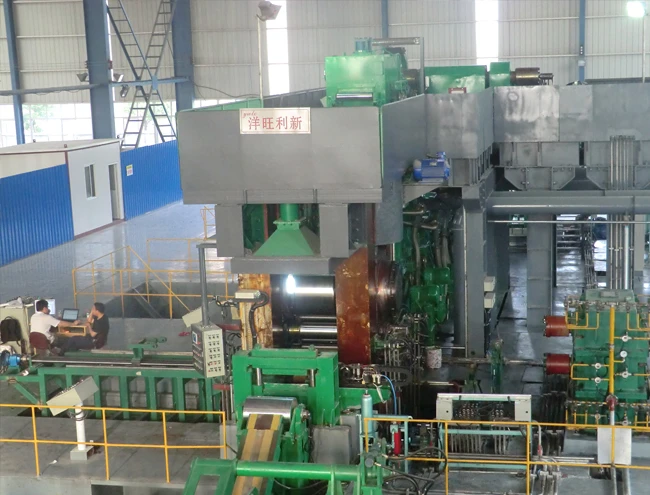
Roll Bonding Cladding | High Strength, Corrosion-Resistant
The Real-World State of Roll-Bonded Cladding: What Manufacturers Are Doing Now
If you’ve been watching metal laminates lately, you’ve probably noticed how roll bonding cladding has edged out older, higher-impact methods. It’s not just a lab trick anymore. On the shop floor, customers keep telling me the same thing: the surface is cleaner, the yields are better, and energy bills aren’t scary.
Quick context: YWLX’s Cladding Rolling Mill (Origin: No.1518, LAR Valley Int'l, Guang’anmen Avenue, Xicheng District, Beijing, 100055) is one of the more pragmatic systems I’ve seen. It combines copper–steel, aluminum–steel, copper–aluminum, aluminum–stainless, and stainless–steel laminations on one line, with widths up to 1000 mm and minimum composite thickness ≈ 0.2 mm. That’s not theoretical; it’s running in production.

Why the shift (and what’s trending)
Explosion bonding and hot rolling did their job for years. But high environmental overhead, inconsistent surfaces, and expensive compliance have pushed buyers toward roll bonding cladding, especially for electronics, decorative strips, chemical process hardware, and—big one—auto parts like battery tabs and busbars. ESG pressures are real, and so are cost-per-part targets.
Process flow at a glance
- Materials: Cu, Al, SS, low-alloy steels (typical surface prep: degrease, brush, light abrasion).
- Stack-up: bi- or tri-layer, optional edge tack-welds to prevent slippage.
- Reduction passes: cold rolling reductions staged for bond activation; optional intermediate anneal.
- Bonding: solid-state diffusion; no filler metal; minimal intermetallics if parameters are tuned.
- Finish: slit, tension-level, coil; surface Ra control for electronics-grade requirements.
Testing and QA (typical): tensile (ASTM E8/E8M), microhardness (ASTM E384), bond peel/shear (in-house methods correlated to ASTM D903-style peel), metallography (ASTM E3/E407). Service life? Around 10–20 years in benign environments; chemical duty depends on alloy pairing and media, so your mileage will vary.
Product specs (Cladding Rolling Mill)
| Parameter | Typical Value | Notes |
|---|---|---|
| Max Coil Width | ≈ 1000 mm | Real-world use may vary ±2% |
| Min Composite Thickness | ≈ 0.2 mm | Bi- or tri-layer |
| Line Speed | 5–60 m/min | Depends on alloy set and reduction |
| Bond Integrity | ≥ 99.5% bonded area | Peel strength often ≥ 12–16 N/mm |
| Energy Use | 20–35% vs. legacy routes | Process-dependent |
| Certifications | ISO 9001, CE (typical) | Ask for current certs |
Vendor landscape (practical comparison)
| Vendor | Alloy Pairs | Min Thickness | Energy Profile | After-Sales |
|---|---|---|---|---|
| YWLX Cladding Rolling Mill | Cu–Steel, Al–Steel, Cu–Al, Al–SS, SS–Steel | ≈ 0.2 mm | Low; cold-route focus | Process tuning + training |
| Vendor A (Hot/Explosion) | Steel–Ni/SS heavy plate | > 2.0 mm | High; batch-intensive | Project-based |
| Vendor B (Cold Rolling) | Limited Cu–Al focus | ≈ 0.3–0.5 mm | Moderate | Basic warranty |
Applications, customization, and some field notes
- Applications: EV busbars, battery tabs, EMI shielding, decorative trim, heat-exchanger plates, chemical clamps, cookware cores.
- Customization: layer count (2–3), ratio (e.g., 70/30 Cu–Steel), coil width up to 1000 mm, finishes (brushed/bright), slit-to-width, edge quality.
- Customer feedback: “surface is finally camera-ready,” one electronics buyer joked. Another cited 18% material cost down by swapping pure Cu for Cu–Steel clad.
Mini case studies
EV connector line: Shifted to Cu–Steel clad for terminals; peel strength averaged ≈ 14 N/mm; scrap down ~25%; takt time stable. To be honest, the operator training made more difference than the brochure promised.
Chemical duty strips: Al–SS laminate for splash zones; corrosion resistance improved visibly in salt-spray screening (ASTM B117, 240 h), with no blistering and intact bond line on cross-sections.
Standards and compliance (what auditors ask)
Procurement teams typically reference ASTM A263/A264/A265 for clad plate families, ASTM E8/E384 for mechanicals, and ISO 9001 for QMS. For peel/shear, many use internal specs aligned to ASTM D903-style methods. It’s not glamorous, but it keeps disputes short.
Citations
- ASTM A263/A264/A265 – Specifications for clad steel plate families.
- ASTM E8/E8M – Standard Test Methods for Tension Testing of Metallic Materials; ASTM E384 – Microindentation Hardness.
- ISO 9001:2015 – Quality management systems requirements; ASTM D903 – Peel or Stripping Strength (method reference).
-
YWLX’s 1450mm Six-Hi Reversing Mill Goes Live in BangladeshNewsNov.24,2025
-
Adjusting Roll Gap in 6Hi Reversing Cold Rolling Mill for Thin StripNewsNov.13,2025
-
Quality Control Standards for Automatic Gauge Control in Strip RollingNewsNov.13,2025
-
Effect of Skin Pass Rolling on Metal DuctilityNewsNov.13,2025
-
Key Components of a Modern TempermillNewsNov.13,2025
-
Common Wear Patterns of Work Roll in Tandem Cold Mill OperationsNewsNov.13,2025
-
Revolutionary Skin Pass Rolling Technology for Enhanced Steel QualityNewsNov.04,2025










